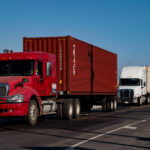This article is part of a sponsored series by Cotality.
There’s a blurry line between where a wildfire ends and a conflagration begins. But, without an understanding of both types of fires, their dynamics, and their unique risks, it is impossible to develop a comprehensive wildfire-related risk management strategy.
A wildfire is an uncontrollable fire that usually begins in the wildlands and is largely fueled by natural vegetation. A conflagration, on the other hand, occurs when a wildfire spreads to the built environment and evolves into a structure-to-structure fire. With manmade materials fueling the flames, conflagrations intensify and accelerate much faster than traditional wildfires could.
Once a wildfire turns into a conflagration, the flames can burn communities to the ground in just a couple hours, or less.
Conflagrations are on the rise, which is why Cotality launched the Wildfire Conflagration model — the first solution of its kind to analyze the risk of conflagration at every structure.
While traditional wildfire models focus solely on the hazard, Cotality’s new model is dedicated to evaluating risk of conflagration in the built environment.
Using a conflagration-specific risk assessment tool in tandem with a traditional wildfire risk evaluation solution like the Cotality Wildfire Risk Score (WFRS) enables insurers to create a more holistic risk management strategy. It is only with mechanisms to look at all angles of wildfire-related risk that insurers can provide more coverage in higher risk areas — without gambling their solvency.
Wildfire and conflagrations: A distinction that matters
Historically, catastrophe risk management professionals classified wildfires as “secondary perils”, believing they did not warrant the same level of modeling scrutiny as did traditional “primary perils,” like hurricanes and earthquakes. But after a decade of rising losses tied to wildfires, the catastrophe community now classifies wildfires as an “emerging secondary peril,” inching their way into the “primary” ranks of hurricanes and earthquakes.
The growing intensity of wildfires over the last decade has prompted many property insurance providers to shift their risk appetite. They are pulling out of the wildfire-prone areas, suspending the renewal of certain policies, and substantially increasing premiums.
This surge in wildfire destruction isn’t due to dramatically shifting weather patterns or increasingly flammable natural vegetation alone. Rather, it’s because wildfires are increasingly becoming wildfire-induced conflagrations, including the 2023 Maui fires and the 2025 Los Angeles fires.
Once considered an exclusively urban threat, conflagrations are now blazing more frequently in suburban and even rural areas. Driving this phenomenon is the rapid expansion of the Wildland-Urban Interface (WUI) — where human development meets natural wildland. These zones have grown quickly in the era of remote work and rising property values, as land in the WUI is often more affordable to build on, particularly in California, while also offering scenic views and proximity to nature. Swaths of new homeowners in these areas inadvertently add fuel to potential fires — quite literally.
Since 2020, there have been 10 major wildfire-induced conflagrations that have resulted in 26,000 structures destroyed in the U.S. The Los Angeles wildfires alone caused between $35 to $45 billion in insured losses, according to Cotality™ data. With events like these happening at least every other year, insurers need to measure the elevated risk that conflagration can bring to their portfolio.
A dual approach for a natural-ish hazard
With conflagration in the mix, wildfires present a complex, multi-dimensional peril. Although different than “all natural” perils, they aren’t uninsurable. With the right risk strategy and digital tools, insurers can make more data-backed risk decisions that enable them to operate in the expanding WUI.
Cotality offers dual views of non-house fire risk through two highly granular, deterministic risk models. These two distinct perspectives helping insurers see past blind spots, delivering a comprehensive assessment of non-house fire risk for any property.
The Cotality Wildfire Conflagration model returns a 1-100 score that insurers can use alongside the 1-100 Wildfire Risk Score to gain a comprehensive view of fire risk for any property. Each score reflects the distinct factors that contribute to conflagration and wildfire risk, respectively, providing straightforward, actionable tools for underwriters and risk managers.
The Wildfire Risk Score (WFRS) considers the following for any property:
- Risk on the property
- Distance to higher hazard areas
- Distance to wildland
- Wind
- Drought
This score zeroes in on the natural wildfire hazard itself and potential impact on properties before the built environment gets in the way.
Then, the Wildfire Conflagration Score considers the following:
- Structure characteristics like roofing and siding composition, combustible attachments, and window materials
- Building density
- Wind direction
- Weather and climate characteristics
- Ember component and all nearby vegetation types
Why both scores are must-haves
Using both scores on every property is critical because a property with one type of fire risk may not be at risk for the other. A property with very low wildfire risk — far enough away from the WUI to raise traditional concern — could be at a very high conflagration risk. A recent analysis by Cotality identified thousands of properties within the Palisades and Eaton Fires with low wildfire risk but high conflagration risk.
When insurers leverage both scores in decision-making processes around eligibility, underwriting, and even pricing determinations, they will have a comprehensive view of risk at the property level.
Conflagration at the core of the wildfire consideration
The ability of insurers to provide widespread, affordable insurance coverage to people across the United States — even in high-risk areas — is critical for both the long-term survival of the insurance system and home ownership.
Cotality’s new Wildfire Conflagration Risk Score, now available in California and other western states shortly, is a key addition to any modern wildfire risk strategy. It is the toolset on the market that answers the two critical questions: How will a fire start? And, how far will it go?
It’s time to make conflagration a part of the wildfire conversation—and to give it the dedicated analysis it demands.
To learn more about Cotality’s wildfire suite, contact us today.
© 2025 Cotality. All rights reserved. While all of the content and information is believed to be accurate, the content and information is provided “as is” with no guarantee, representation, or warranty, express or implied, of any kind including but not limited to as to the merchantability, non-infringement of intellectual property rights, completeness, accuracy, applicability, or fitness, in connection with the content or information or the products referenced and assumes no responsibility or liability whatsoever for the content or information or the products referenced or any reliance thereon. Cotality™, the Cotality logo, and Intelligence beyond bounds™ are the trademarks of CoreLogic, Inc. d/b/a Cotality or its affiliates or subsidiaries.
Topics Catastrophe Natural Disasters Wildfire
Was this article valuable?
Here are more articles you may enjoy.



 Trump to Issue Order Creating National AI Rule
Trump to Issue Order Creating National AI Rule  Death at Universal’s Orlando Resort Roller Coaster Ruled Accidental
Death at Universal’s Orlando Resort Roller Coaster Ruled Accidental  Truckers Who Fail English Tests Are Pulled Off Roads in Crackdown
Truckers Who Fail English Tests Are Pulled Off Roads in Crackdown  Acrisure to Buy MGA Vave From Canopius
Acrisure to Buy MGA Vave From Canopius 

